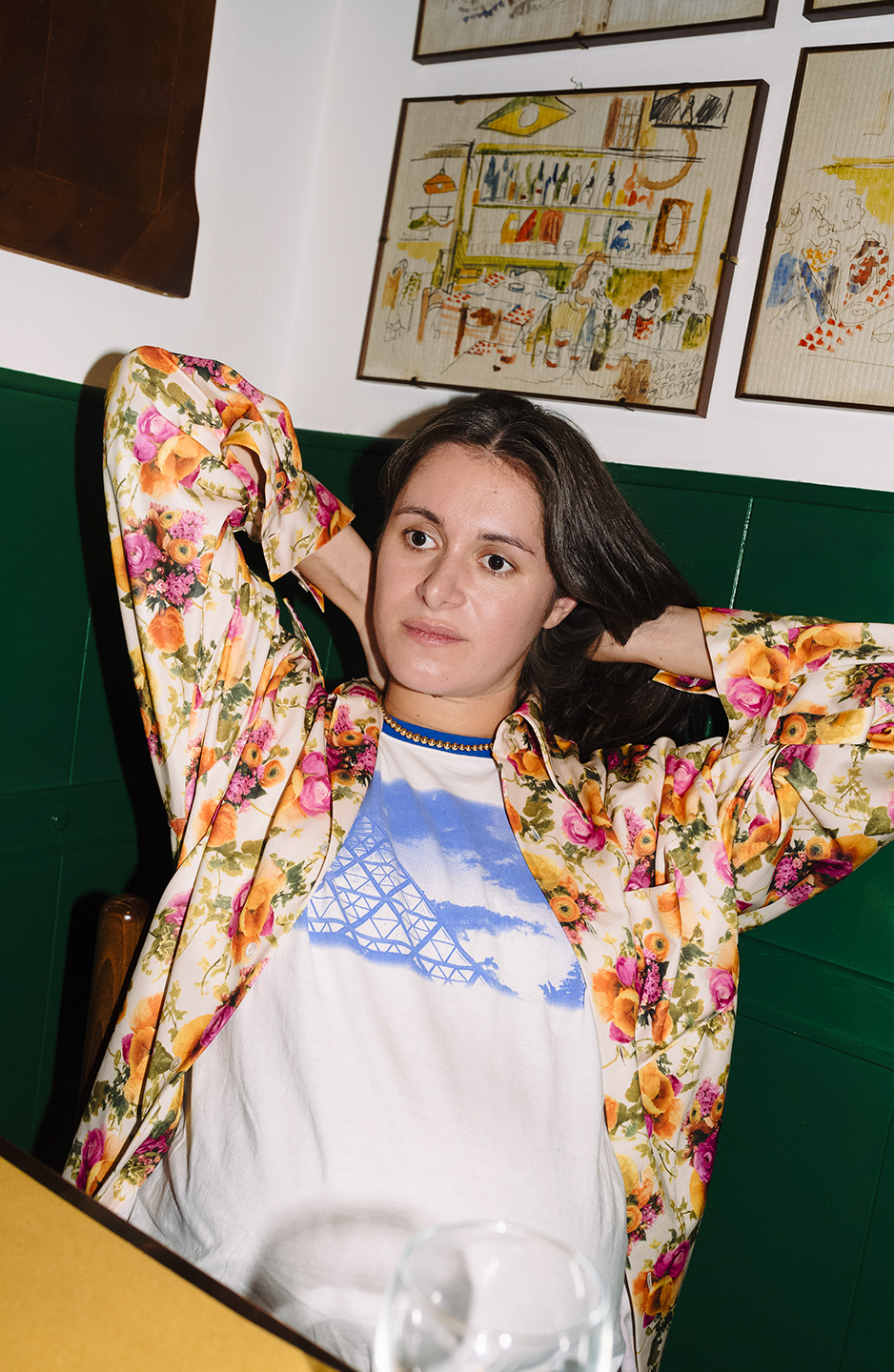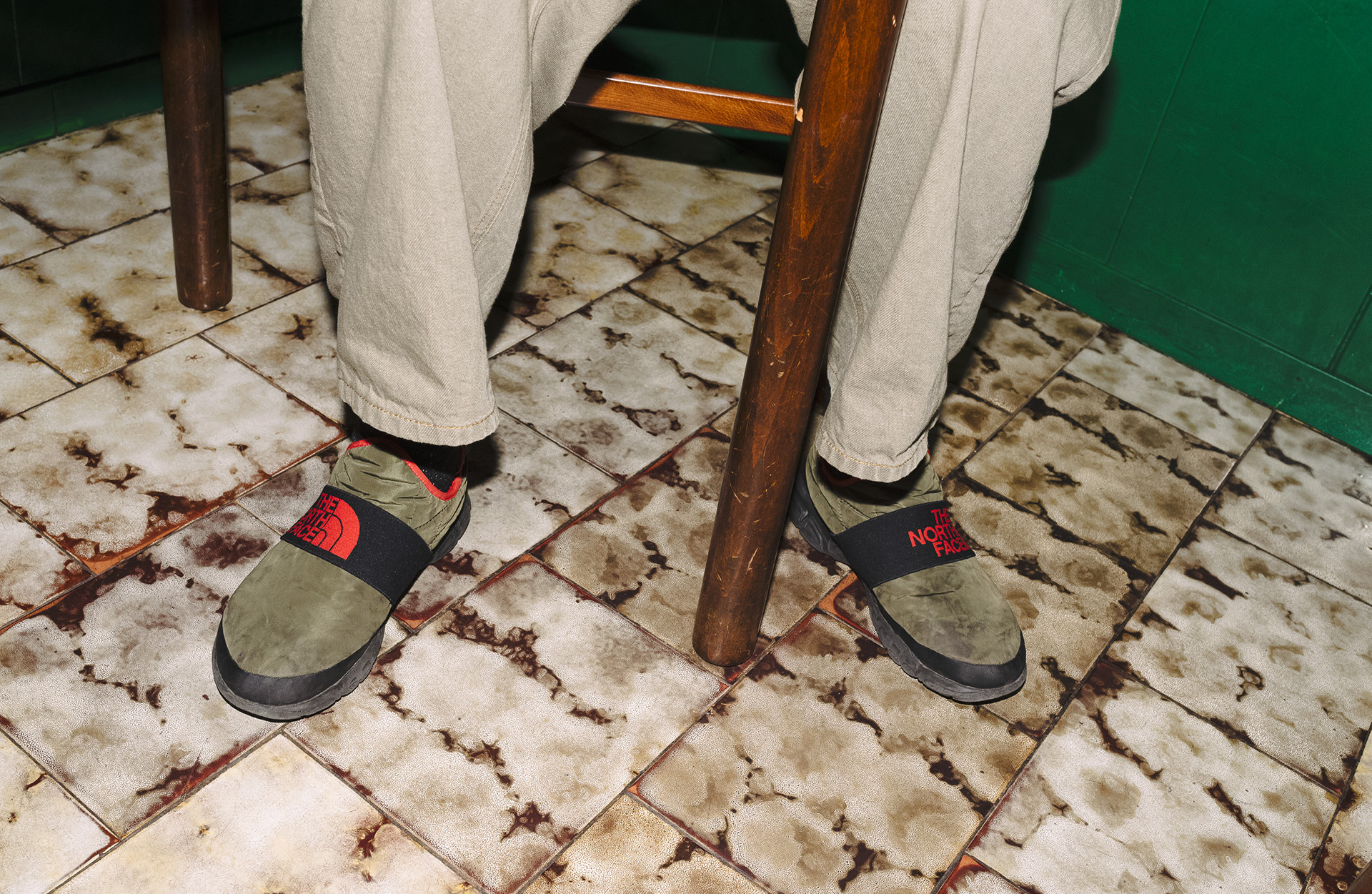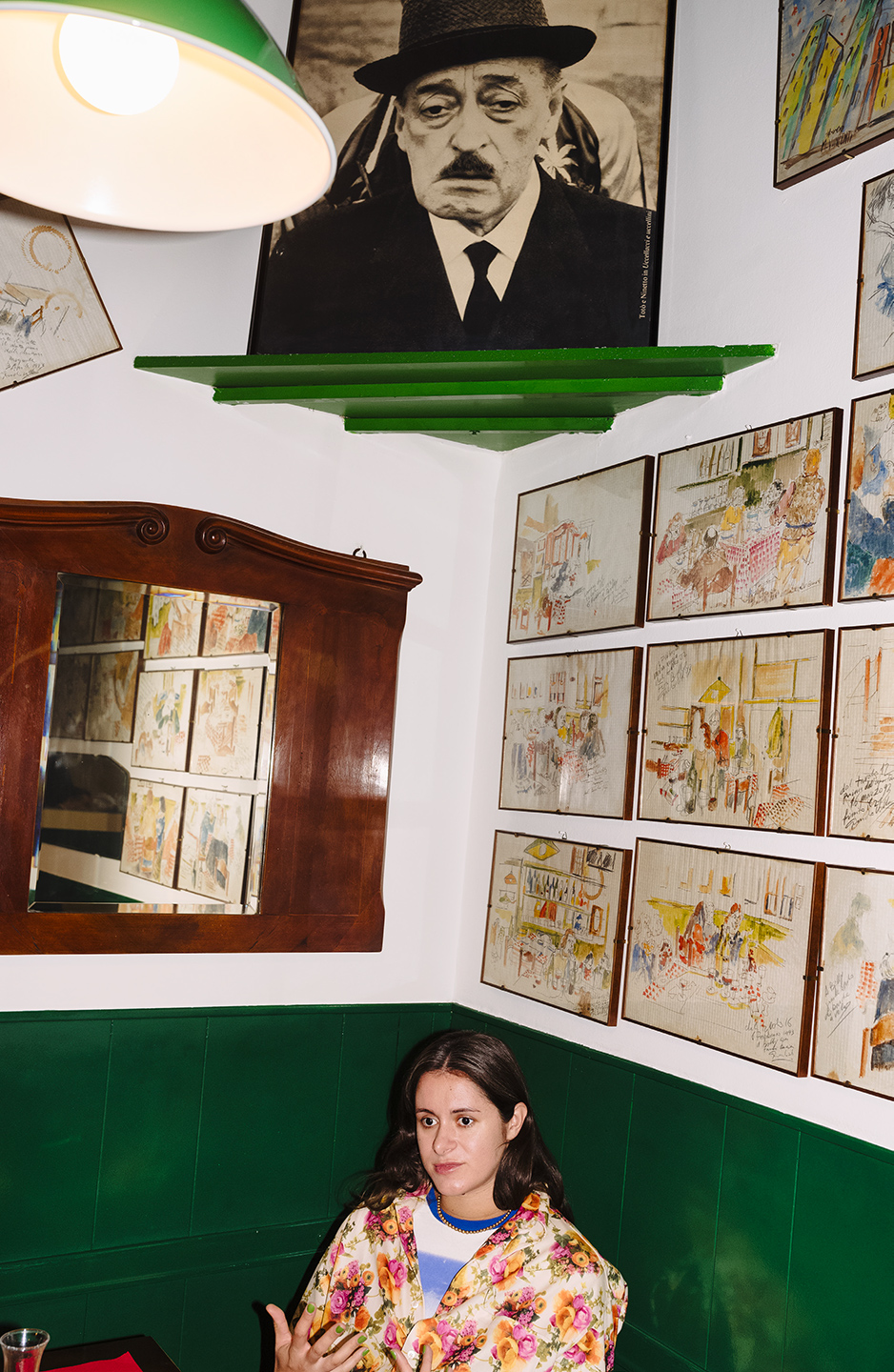Dinner with designer Jezabelle Cormio
at Trattoria da Abele in Via Temperanza Milano
Conversation with Silvia Schirinzi Photography Piotr Niepsuj

-
The atmosphere in the typical Milanese trattoria is cosy, the menu changes every three days but it’s one of those places where everything is delicious. Jezabelle is thirty years old and lives in Rome. She’s a bit Italian, a bit American and a bit Croatian, and she is expecting her first child. The idea for Cormio developed during the four years spent at the Royal Academy of Fine Arts in Antwerp, where she studied Fashion Design, while in embryonic form it dates back to at least 2013, when Humberto Leon and Carol Lim, creative directors of Opening Ceremony at the time, chose her and another two students to develop a collection for their brand. Since then, the designer has worked on various projects and created three complete collections. The latest two – Autumn Winter 2020 and Spring Summer 2021 – were presented respectively with a runway show during the “Sagra dei Pizzoccheri” [a traditional local food festival, Ed.] in Seveso, and at Spazio Maiocchi in Milan with a gender reveal party sui generis. At the heart of Cormio’s aesthetic universe is a bizarre fascination with anything and everything Tyrolese, or rather, all the mock South-Tyrolese objects that adorn Italian homes and narrate a certain, very bourgeois, conception of holidaying and underlining one’s social standing. An idea that is rife with contradictions, and which is transformed by Cormio’s collections, where it gains enough distance from the folkloric to break it down from within. This is what we talked about.
-
SSThe number of cases in Italy is rising again and it feels a bit strange to be out for dinner. How did you spend lockdown?
-
JCWhen we went into lockdown, I had just concluded the winter sales campaign in Paris; we came back to Milan for a day and then I went out to meet my partner in New York. After a few days in the city, we realised that things were getting bigger... Then a few days later they closed Lombardy and then Italy, and that was that. I thought, “God, if I managed to get over here without anyone asking any questions, it means this thing is growing without anybody realising”. And that’s exactly what was happening. We decided to go to Maine, and we stayed in a house in the forest for a month. People weren’t as scared of the virus in the US as in Italy, but it was a very isolated place with very few inhabitants and they were all very aware who lived there and who was an outsider so we stood out. We had a New York number plate, and you could see that we weren’t from around there. At one point we felt a bit uncomfortable. Then Covid exploded in New York too and people began leaving the city for their second homes in more isolated places, the same way they did in Italy after the 7th of March.
-
SSIs there a particular moment that you remember from that time? I’ve read that many psychologists think it’s difficult for us to “form” memories of the lockdown, despite it being an unprecedented situation, because the days all merged into one.
-
JCWell, definitely the moment I found out I was pregnant. I was in Maine and I had managed to get one last order of pancakes in before all the restaurants shut but I felt sick after one mouthful. That’s when I began to wonder. I thought, “I must need a coffee, I need to wake up,” but that made me sick again, it was as though the breakfast was trying to kill me. From there, we embarked on the adventure of finding out what it meant to be pregnant. At first, the doctors didn’t want to see me in the hospital because they had found out I was from Milan and Milan was the epicentre of the pandemic at the time, so it was a bit difficult. When we realised that I would have to return to Italy to get the medical check-ups I needed, we had to fly to Rome because the only flights operating from the US to Italy were from New York to Rome. When we got to New York, the city was really terrifying: the streets were empty except for ambulances and fire engines. It felt like a post- apocalyptic city, especially in the evening. We managed to get back to Italy on the 13th of April and seeing a doctor was complicated even then given the time I needed to quarantine for and where I was at in my pregnancy. The whole thing seemed so surreal and intense that I almost couldn’t grasp how serious it was. I was very sad, of course, especially about the number of deaths, I was glued to the news.
-
SSDid you always want to have your own brand, or did you expect to take the style- department route first?
-
JCWhen I was at school, I thought I’d take the classic route but then in the fourth year there was this Opening Ceremony initiative that was held in a different country each year. That year it was in Belgium. So they [Humberto Leon and Carol Lim, Ed.] came to the academy and chose three designers and I was one of them. They commissioned a collection with the pieces we were making for our Master’s, so I graduated and then a week later I was in Rome trying to put this entire production together. It was 2013. The focus of the Antwerp school is very much on allowing you to develop your brand, even as a student, perhaps even without a logo. The school’s goal is for you to develop your DNA as a designer. And if you can’t then that’s a problem.
God, if I managed to get over here without anyone asking any questions, it means this thing is growing without anybody realising.

-
SSSpeaking of Antwerp, how did this experience influence you and what do you think are the ingredients for a good fashion school?
-
JCI moved to Antwerp when I was 18 years old, so it was a very unique experience. Thinking back on it, it’s a place I love, and I’d live there again. It’s a flat city so you can literally look into people’s houses when you’re walking along the street and sometimes you see crazy scenes. As for the school, I have to say that it was really very hard. I struggled at first because I felt much younger than the others. There were people there who had studied advertising, or graphic design, or product design, so everybody there already had a fairly sold personal style. I didn’t really understand what I was doing at the beginning, but I had got a mark of 16 in the entrance exam, which was one of the highest marks. And then I had a professor who put so much pressure on me that I eventually began to react and feel more in charge of the situation.
-
SSThe first Cormio runway show, for the Autumn Winter 2020 show, took place during a sagra, a traditional local food festival, in the small town of Seveso. Can you tell me about this decision?
-
JCI had actually already made a Cormio collection, but I think of the Seveso one as the first. When I lived in Bassano, I had already begun to make small collections that I sold on Opening Ceremony, which had continued to support my brand over the years. The AW 2020 collection therefore included many pieces that I had already developed. I chose Seveso because it was outside Milan, and it had these marquees, these open spaces. It wasn’t the first sagra we visited but we chose it because everything about it felt ideal. It was the festival of pizzocccheri [a buckwheat pasta dish typically eaten in northern Italy, Ed.] and porcini mushrooms and it was very famous in the area, it is a regular event attended by loads of people. We handled all the organisation and we brought people to walk the runway as well as scouting some of the young waiters, who were really great and really willing. We tried to teach them how to “walk” a runway.
-
SSWhat inspires you when you have to design a collection and how do you structure your creative process?
-
JCI tend to imagine everything as one growing collection, occasionally I might leave some pieces behind and add others, but it’s always the same vein for me. And I think that’s important because – ideally – I’d like to keep on making clothes that I’m not embarrassed of six months down the line. It is important that they are pieces that I will continue to love over time and for me that is the real meaning of sustainable design: make things that you don’t then think of as obsolete as time passes.
I moved to Antwerp when I was 18 years old, so it was a very unique experience. Thinking back on it, it’s a place I love, and I’d live there again. It’s a flat city so you can literally look into people’s houses when you’re walking along the street and sometimes you see crazy scenes.

-
SSWhat relationship do you have with South Tyrol, why is it the centre of your creative vision?
-
JCI am not Tyrolese, but I grew up seeing Tyrolese objects in every kitchen and every living room, except my own. But this summer, for example, when I was at my aunt’s house in Puglia, I noticed that her kitchen was full of Tyrolese objects, from bread bins to cloths. This passion for Tyrolese objects is a bit of a bourgeois obsession: from clogs to clothes, and oven gloves to curtains. They are objects that show that you are somebody who goes skiing in the Dolomites instead of going to the seaside, that you know the value of the mountain lifestyle. It is a style that shows off your social class. It is a very pragmatic souvenir. They are seen as items of quality, and they are, often they are very expensive items. But in spite of that, the patterns for the clothes are actually very simple, the food is very genuine and not very “gourmet”, and their knitting techniques are very simple too. I really like this contradiction. The things we make with Cormio are very complex from a production perspective compared to traditional Tyrolese clothing. There is something folkloric about Tyrolese items that is very well received even today, which is interesting because there is a difference in perception compared to other types of folklore which are often looked down upon. My inspiration might change over time or perhaps I will find the “Tyrolese way” of doing other things... the Tyrolese way of being elegant or goth or more romantic or sporty.
-
SSWhat is your take on the discussion around cultural appropriation?
-
JCI wonder how it’s going to end, as I personally think that we’ve only just begun to touch on this topic. In general, [as a designer, Ed.], I don’t see anything wrong with getting swept up in a sensation that you might only have seen in China, but this can have a million different facets. I might be attracted to something very specific, Chinese women who wear T-shirts with English slogans that don’t make sense, for example. That’s “Chinese” too. Perhaps in the future I could focus on the way that certain cultures are abandoning their traditional garments or how these garments are changing nowadays to almost ridiculous effect.
A male friend of mine actually just sent me some photos of the Cormio clothes he bought, and he looks great in them.

-
SSI think that your work contains a very powerful feminine element which does not necessarily translate into your clothes being solely for women. When you design your clothes, do you have a specific person in mind?
-
JCNo. A male friend of mine actually just sent me some photos of the Cormio clothes he bought, and he looks great in them. After the winter season before Covid, we began seeing all our female friends, or friends of friends [who had bought Cormio pieces, Ed.] and that created a sort of circle, a group that I see as our clients. I always think of them, now that I know them and have seen how much fun they have with my clothes. That person used to be me, I would design for myself, while now we have a game where we name new models after our clients... Alma, Daria, and so on.
-
SSHow hard is it nowadays to maintain and grow a fashion brand in Italy and in the middle of a pandemic?
-
JCThe business side of things is a chore for me, so I try to keep creative even though I have to do a lot of things that are far from it. It is a strange time, I still haven’t really felt the impact of it all on my small company. Fortunately, nobody cancelled their orders with us, which was something that the industry was really scared of.
